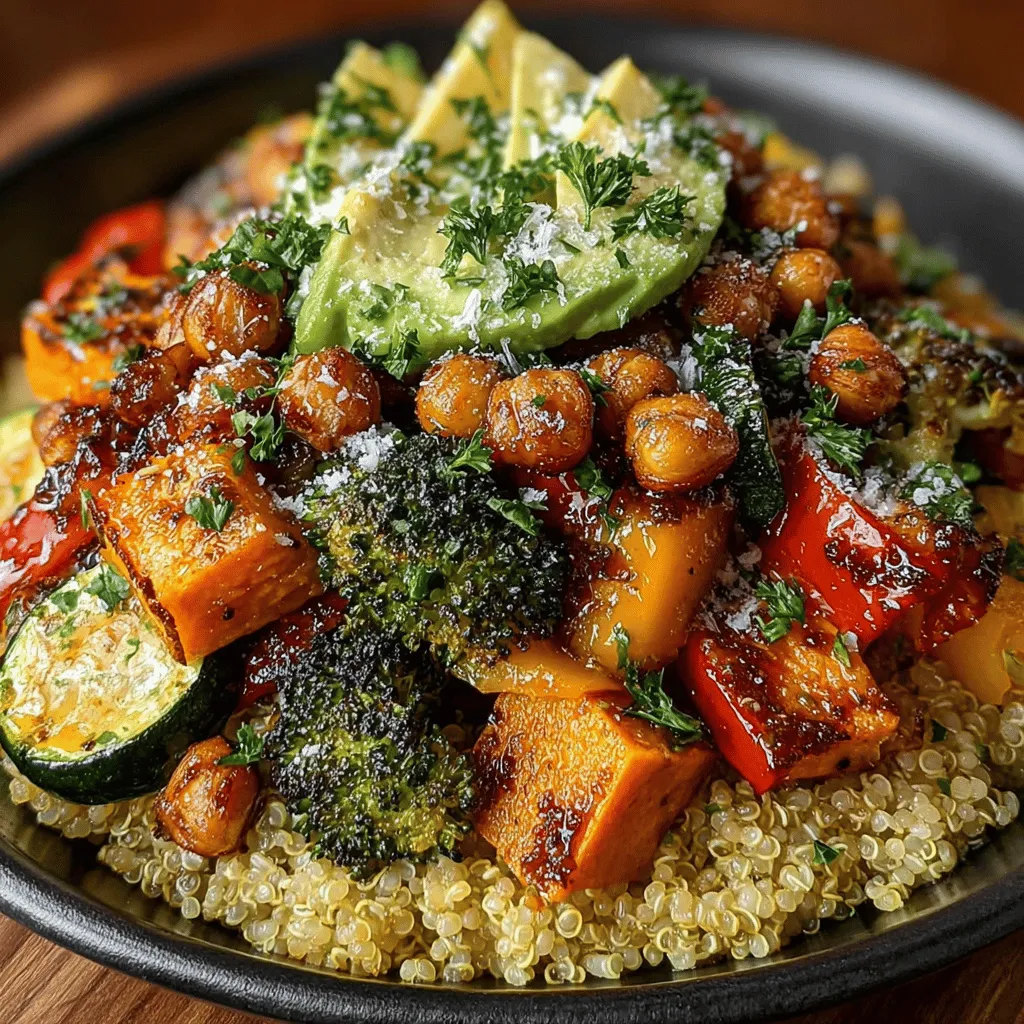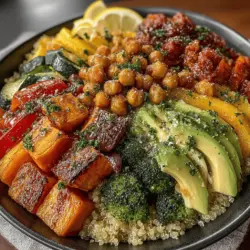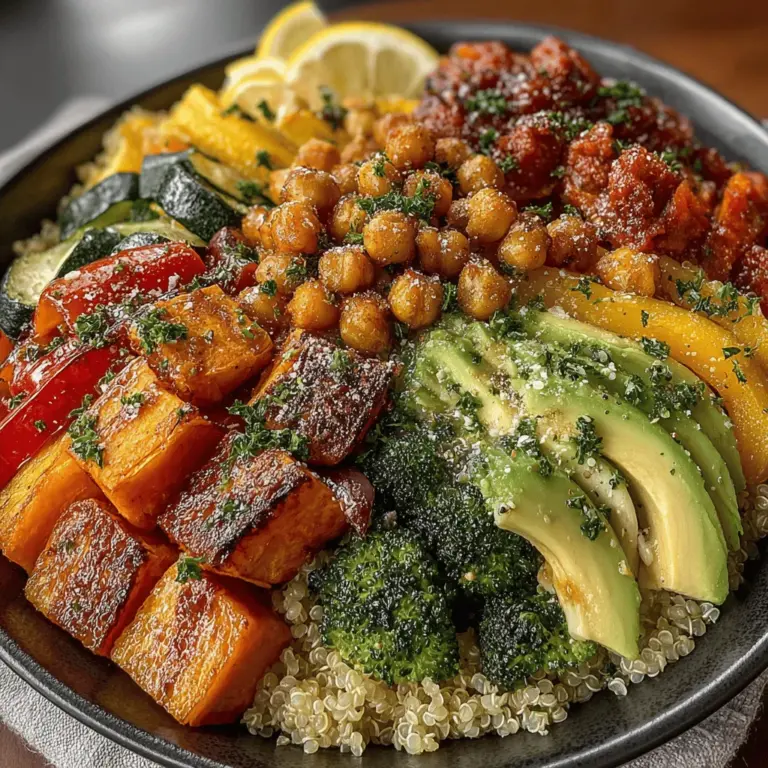Introduction
Power bowls have surged in popularity as a convenient and nutritious meal option, appealing to health-conscious eaters everywhere. Among these vibrant dishes, the Quinoa and Roasted Veggie Power Bowl stands out as a delightful combination of flavors and textures. This recipe not only packs a punch in terms of taste but also offers a wealth of nutrients, making it an excellent choice for meal prep or a quick weeknight dinner. Whether you’re following a plant-based diet, looking to boost your protein intake, or simply seeking a colorful, wholesome meal, this power bowl is highly adaptable to various dietary preferences.
Ingredients
– 1 cup quinoa, rinsed
– 2 cups water or vegetable broth
– 1 medium sweet potato, diced
– 1 bell pepper, chopped (any color)
– 1 zucchini, sliced
– 1 cup broccoli florets
– 1 can (15 oz) chickpeas, drained and rinsed
– 2 tablespoons olive oil
– 1 teaspoon garlic powder
– 1 teaspoon smoked paprika
– Salt and pepper, to taste
– 1 avocado, sliced
– Fresh herbs for garnish (optional)
Instructions
1. Preheat your oven to 425°F (220°C).
2. In a medium saucepan, combine the rinsed quinoa and water (or vegetable broth). Bring to a boil, then reduce heat to low, cover, and simmer for 15 minutes, or until the liquid is absorbed. Remove from heat and let it sit covered for 5 minutes.
3. While the quinoa is cooking, prepare the vegetables. Place the diced sweet potato, bell pepper, zucchini, and broccoli in a large bowl.
4. Drizzle the vegetables with olive oil, garlic powder, smoked paprika, salt, and pepper. Toss until evenly coated.
5. Spread the seasoned vegetables on a baking sheet in a single layer. Roast in the preheated oven for 20-25 minutes, or until tender and slightly caramelized, stirring halfway through.
6. Once the quinoa and vegetables are ready, assemble the power bowls by dividing the quinoa among serving bowls. Top with the roasted veggies and chickpeas.
7. Add sliced avocado on top and garnish with fresh herbs if desired. Serve immediately or store in the refrigerator for meal prep.
Understanding Power Bowls
Power bowls are essentially a balanced meal in a single bowl, designed to provide a variety of nutrients and flavors. They typically combine grains, vegetables, proteins, and healthy fats, offering a complete meal that is satisfying and nourishing. The Quinoa and Roasted Veggie Power Bowl exemplifies this concept with its diverse array of ingredients, which can be easily customized to suit individual tastes and dietary needs.
The growing interest in plant-based diets has further popularized power bowls, as they often feature a plethora of colorful vegetables and plant proteins. This particular recipe aligns perfectly with this trend, showcasing the vibrant colors and textures of fresh produce while delivering essential vitamins, minerals, and antioxidants.
Ingredients Breakdown
Quinoa
Quinoa is a nutrient-dense grain that serves as the base of this power bowl. It’s gluten-free and offers a complete protein profile, containing all nine essential amino acids. This superfood is also rich in fiber, magnesium, and B vitamins, making it a healthful choice for any meal.
Sweet Potato
Sweet potatoes are not only delicious but also a nutritional powerhouse. They are high in vitamins A and C, fiber, and antioxidants. Their natural sweetness and creamy texture complement the other ingredients in the bowl beautifully.
Bell Pepper, Zucchini, and Broccoli
These colorful vegetables add a variety of nutrients and flavors to the dish. Bell peppers are high in vitamin C, while zucchini provides hydration and fiber. Broccoli is a cruciferous vegetable known for its cancer-fighting properties and high levels of vitamins K and C.
Chickpeas
Chickpeas are an excellent source of plant-based protein and fiber, making them a perfect addition to the Quinoa and Roasted Veggie Power Bowl. They help keep you full and satisfied while adding a nutty flavor to the dish.
Olive Oil
Using olive oil in this recipe not only enhances the flavor of the roasted vegetables but also adds healthy fats that are beneficial for heart health. Rich in monounsaturated fats and antioxidants, olive oil is a staple in healthy cooking.
Avocado
The addition of avocado brings creaminess to the bowl, along with a wealth of nutrients. Avocados are a great source of healthy fats, vitamins E and K, and folate, making them a nutritious topping for any dish.
Seasonings
Garlic powder and smoked paprika elevate the flavor profile of the roasted vegetables, adding depth and warmth. These seasonings are an essential part of the recipe, enhancing the overall taste without the need for excess salt or unhealthy additives.
Cooking Method
Preparing the Ingredients
To create your Quinoa and Roasted Veggie Power Bowl, begin by rinsing the quinoa thoroughly under cold water to remove its natural coating, called saponin, which can impart a bitter flavor. Meanwhile, prepare the vegetables by washing and chopping them into bite-sized pieces, ensuring even cooking during roasting. The next step is to season the vegetables, which will enhance their natural flavors and make them a delicious addition to the bowl.

Tips for Perfect Quinoa and Roasted Veggie Power Bowls
Rinsing and Cooking Quinoa
To achieve the best texture for quinoa, it is essential to rinse it thoroughly before cooking. This step removes the natural saponins that can impart a bitter taste. Place the quinoa in a fine-mesh strainer and rinse it under cold water for about 2-3 minutes, gently rubbing the grains with your fingers. After rinsing, combine the quinoa with water in a pot using a 2:1 water-to-quinoa ratio. Bring it to a boil, then reduce the heat to low, cover, and simmer for about 15 minutes until the water is absorbed. Let it sit for an additional 5 minutes off the heat before fluffing with a fork.
Importance of Uniform Vegetable Cutting
Cutting your vegetables into uniform sizes is crucial for even roasting. Smaller pieces will cook faster, while larger ones may remain undercooked. Aim for bite-sized pieces, approximately 1-inch cubes, to ensure they all roast evenly. This not only enhances the visual appeal of your power bowl but also guarantees that each bite is packed with flavor.
Roasting Techniques
Optimal Oven Temperature
Roasting vegetables requires a high oven temperature, typically between 400°F and 425°F. This range allows for caramelization, which enhances the natural sweetness of the vegetables. The high heat also helps in creating a crispy exterior while keeping the inside tender.
Tips for Even Cooking
To ensure your vegetables are evenly cooked and flavorful, spread them in a single layer on a baking sheet. Overcrowding can lead to steaming rather than roasting. Toss the vegetables in olive oil and seasonings before placing them in the oven. Stir them halfway through the roasting time to promote even browning.
Assembling the Power Bowl
Visual Presentation Tips
When assembling your power bowl, layer the ingredients for an appealing visual presentation. Start with a base of quinoa, followed by a colorful array of roasted vegetables. Add protein options like chickpeas or grilled chicken, then finish with fresh greens or avocado. Drizzle with a dressing of choice for added flavor.
Serving Sizes and Customization
Serving sizes can be adjusted based on appetite and dietary needs. A good rule of thumb is 1 cup of quinoa, 1-2 cups of assorted vegetables, and ½ cup of protein per bowl. Customize your power bowl by incorporating seasonal vegetables or varying the grains, such as brown rice or farro, to suit personal preferences.
Ideas for Variations
Experiment with different combinations by adding roasted sweet potatoes, sautéed mushrooms, or leafy greens like kale or spinach. For protein, consider grilled shrimp, tofu, or a hard-boiled egg. You can also try different dressings, such as tahini or balsamic vinaigrette, to switch up the flavor profile.
Health Benefits of Quinoa and Roasted Veggie Power Bowls
Nutritional Breakdown
Quinoa is a complete protein, containing all nine essential amino acids, making it an excellent choice for plant-based diets. A typical serving of quinoa (1 cup cooked) contains about 8 grams of protein, 5 grams of fiber, and is rich in vitamins and minerals like magnesium and phosphorus.
Positive Impacts of a Plant-Based Diet
Incorporating quinoa and roasted veggies into your meals can significantly enhance your nutrient intake. A plant-based diet has been linked to lower risks of heart disease, diabetes, and certain cancers. It also promotes weight management and improved digestion.
Dietary Restrictions
This recipe is naturally gluten-free and can fit into vegan diets, making it a versatile option for various dietary restrictions. It is easily adaptable to cater to different preferences and requirements.
Meal Prep and Storage Tips
Preparing in Advance
To save time during busy weeks, consider preparing your quinoa and roasted veggies in advance. Cook a large batch of quinoa and roast a variety of vegetables, then store them separately in airtight containers in the fridge. This allows for quick assembly of power bowls throughout the week.
Best Practices for Storing Leftovers
Leftover power bowls can be stored in the refrigerator for up to 4 days. Ensure that the vegetables and quinoa are cooled before sealing them in containers to maintain freshness.
Reheating Suggestions
To reheat without losing texture and flavor, place the quinoa and veggies in a microwave-safe dish and add a splash of water. Cover and heat in short intervals, stirring in between, until warmed through. Alternatively, you can reheat in a skillet over medium heat for a few minutes.
Conclusion
Quinoa and roasted veggie power bowls are not only versatile but also packed with health benefits. They provide a nutritious and delicious option for meals that can easily fit into any dietary lifestyle. Integrating this recipe into your regular meal rotation can enhance your overall well-being and encourage healthy eating habits. Embrace the spirit of wholesome, flavorful meals with this power bowl, and enjoy the satisfaction of nourishing your body with every bite.


